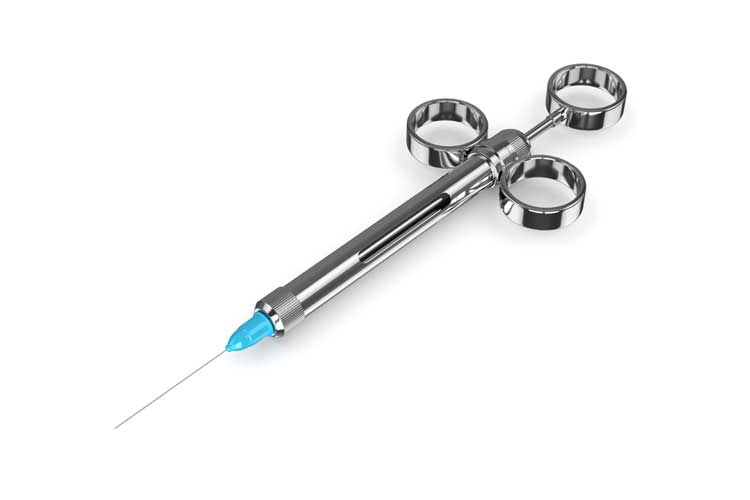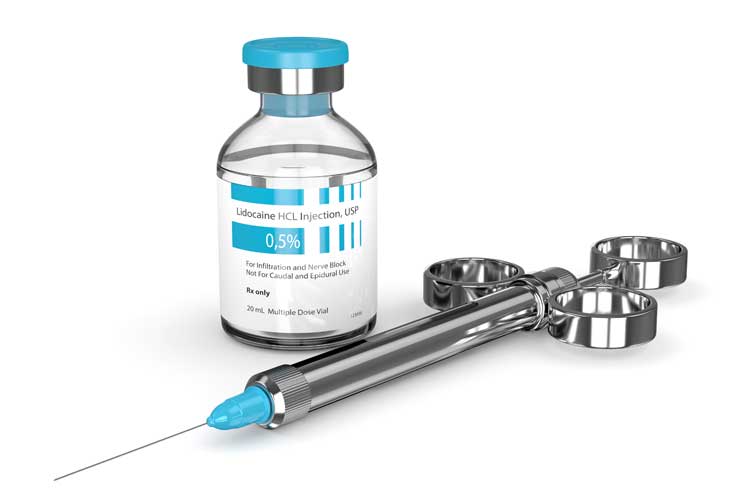Improving Delivery With Alternative Injection Techniques
When using traditional injection techniques to anesthetize a maxillary quadrant, up to five injections are required: posterior superior alveolar (PSA), middle superior alveolar (MSA), and anterior superior alveolar (ASA) nerve blocks and greater palatine (GP) and nasopalatine (NP) injections.

Improving Delivery With Alternative Injection Techniques
When using traditional injection techniques to anesthetize a maxillary quadrant, up to five injections are required: posterior superior alveolar (PSA), middle superior alveolar (MSA), and anterior superior alveolar (ASA) nerve blocks and greater palatine (GP) and nasopalatine (NP) injections. This approach is time consuming and can cause patient discomfort. By utilizing the infraorbital (IO), anterior middle superior alveolar (AMSA), and maxillary nerve blocks, clinicians can reduce the amount of local anesthetic administered, decrease the time spent administering local anesthesia, and minimize the number of needle penetrations required for successful pain control.
Photo Credit: aywan88 / E+

Infraorbital Nerve Block
The IO nerve block is administered at the IO foramen where the IO nerve exits the skull. This block anesthetizes both the ASA and MSA nerves with one injection, reducing the number of needle penetrations and the amount of anesthetic required to cover the area.
Indications:
1. Procedures involving multiple maxillary anterior or premolar teeth such as quadrant dentistry or periodontal therapy
2. When infiltrations are contraindicated due to infection or the density of cortical bone; bone density is not usually a concern on the maxilla
Contraindications:
1. Isolated areas of treatment (one tooth or two teeth only)
2. When hemostasis is desired (the block is administered at the IO foramen; no hemostasis in the gingiva is observed)
Photo Credit: ayo888 / iStock / Getty Images Plus

Technique for Infraorbital Nerve Block
A 25- or 27-gauge long needle is recommended for the IO nerve block. The penetration site is the height of the mucobuccal fold, adjacent to the maxillary first premolar. The barrel of the syringe should be positioned along a line following the long axis of the maxillary first premolar to the IO notch. The needle needs to be advanced slowly, aiming toward the guide finger and maintaining an angle parallel to the long axis of the maxillary first premolar until gently contacting the IO rim (approximately 16 mm in adults or 1⁄2 of a long needle). It is important to advance the needle until bone is contacted, which may be less than 16 mm in some individuals. The needle should then be withdrawn 1 mm.
Photo Credit: diego_cervo / iStock / Getty Images Plus

Anterior Middle Superior Alveolar Nerve Block
The anterior middle superior alveolar (AMSA) nerve block is often used in esthetic dentistry. It anesthetizes the ASA, MSA, GP, and NP nerves with a single injection. Because this injection is delivered on the palate, the upper lip is not anesthetized. An unaltered smile-line is sometimes needed if the dentist needs to evaluate the margins of anterior crowns or veneers.
Indications:
1. When anesthesia is needed for multiple areas of the maxilla
2. Esthetic dentistry procedures that require a smile-line evaluation
3. If infiltrations have been ineffective due to cortical bone density
Contraindications:
1. Patient is unable to tolerate a long injection time
2. Procedures in which more than 90 minutes of anesthesia are necessary
3. If the palatal tissue is too thin; spongy sites better accommodate the necessary volume of solution (a cotton-tip applicator can be used to find a depressible site)
Photo Credit: danchooalex / iStock / Getty Images Plus

Technique for Anterior Middle Superior Alveolar Nerve Block
A 27-gauge short needle is recommended for this injection. The penetration site for the AMSA is located on the hard palate between the apices of the first and second premolars, halfway between the midline and the gingival margin. Because this is a palatal injection, the use of a cotton-tip applicator to apply pressure adjacent to the penetration site may increase patient comfort. Pressure should be applied for a minimum of 30 seconds prior to the injection, and maintained during the injection until additional blanching from the anesthetic diffusion is observed.
Photo Credit: patrisyu / iStock / Getty Images Plus

Maxillary Or Second Division Nerve Block
The maxillary block anesthetizes the entire maxillary branch (often referred to as V2 or the second division) of the trigeminal nerve, which results in profound anesthesia of the entire maxillary quadrant. With the maxillary block, profound anesthesia is achieved for the entire quadrant in one injection for facial and lingual structures. This approach reduces the amount of anesthetic solution needed to only one cartridge (1.8 mL), increasing patient safety. There are two common intraoral approaches for this injection: the facial or high-tuberosity approach and the GP or palatal approach.
Indications:
1. Quadrant dentistry or periodontal therapy
2. When infection on the maxilla prevents the use of traditional maxillary injections
3. Patient fear of multiple injections
Contraindications:
1. Increased risk of bleeding
2. Patients on anticoagulant therapy
3. Patients who bruise easily
4. Uncooperative patients
5. Infection in the area of injection
6. Pediatric patients due to prolonged administration time and because children often have difficulty remaining still
Photo Credit: ayo888 / iStock / Getty Images Plus

Technique for Maxillary Or Second Division Nerve Block
A 25-gauge long needle is recommended for this injection but a 27-gauge is acceptable. The penetration site for the maxillary block is the height of the mucobuccal fold distal to the maxillary second molar (the same penetration site used for the PSA nerve block). Prior to placing topical anesthetic, it is important to use a finger to feel along the facial aspect of the maxilla to find the zygomatic process, which is usually located above the first maxillary molar. It is important to insert distal to the zygomatic process or the maxillary bone may be scraped during administration. The angle of the syringe should be 45° from the mid-sagittal plane, as well as 45° apically from the maxillary occlusal plane. A helpful visual guide for this angle is a line running from the lateral periphery of the ala of the nose to the inside corner of the opposite eyebrow. The average depth of penetration for the maxillary block is 30 mm. With a 32 mm long needle, 2 mm of needle should remain visible outside the tissue. The clinician should administer this injection slowly (taking more than 60 seconds to deliver the full amount) because of the highly vascular nature of the pterygopalatine fossa.

